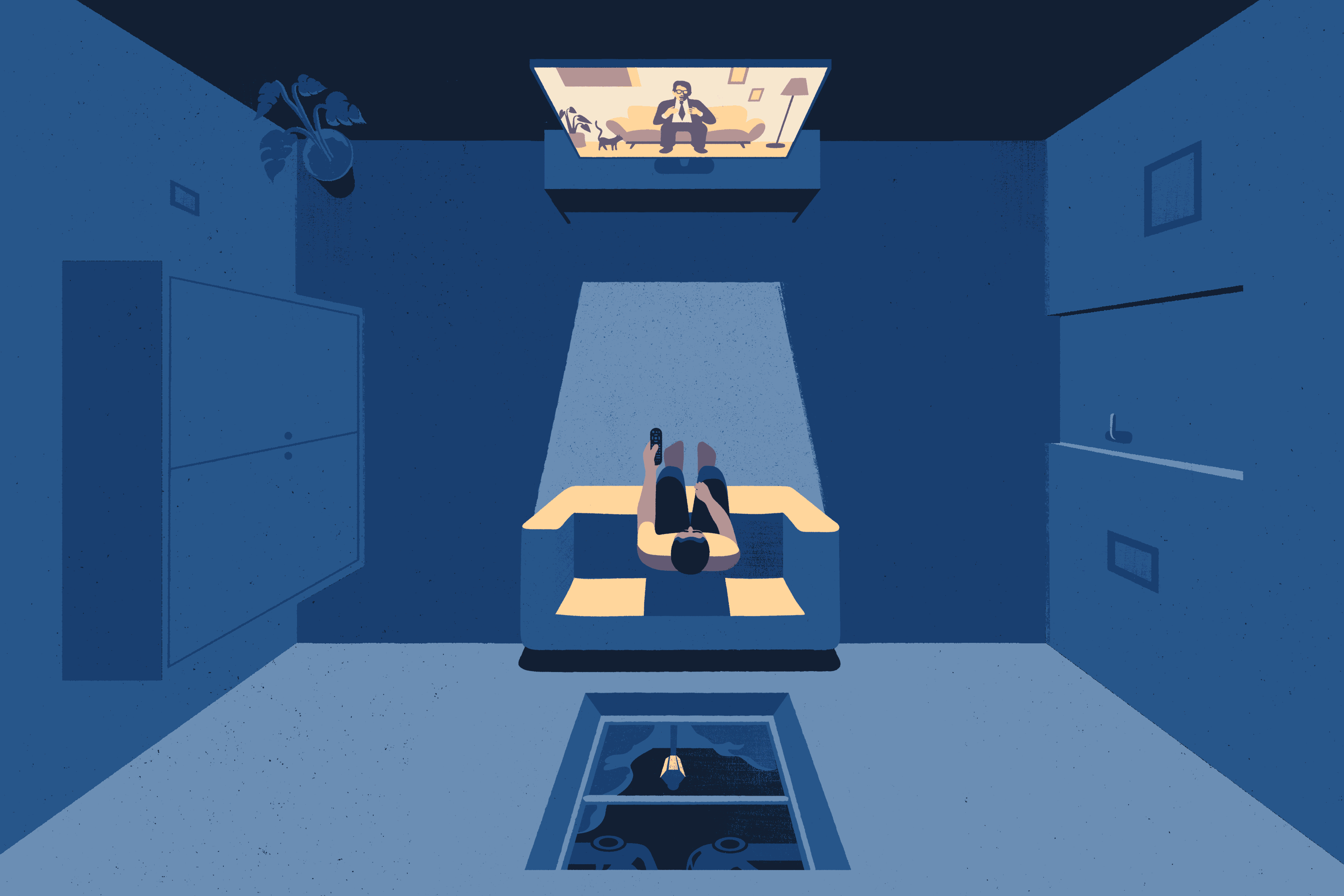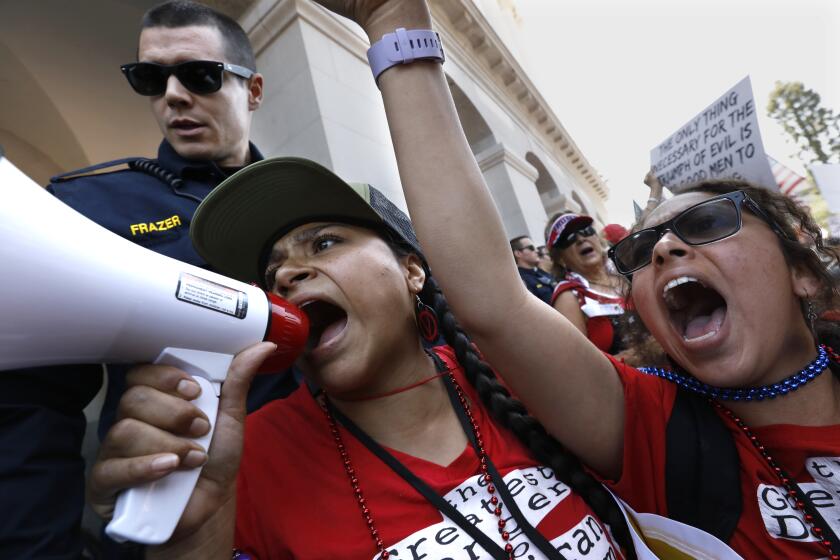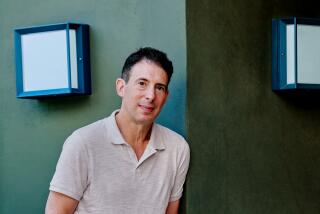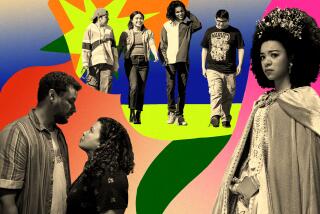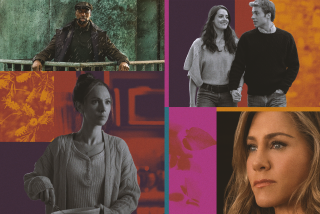TV adapted quickly to coronavirus. Does it have the guts to show what comes next?
- Share via
We have been telling stories about the Almost End of the World for a long time now: supernatural or scientific, cosmological cage match or nuclear holocaust, zombie apocalypse or the withering of an abused planet, now underway. With a bang, with a whimper. And now here we are, in an unexpected if long-anticipated moment, living out old fictions.
In Saturday matinee terms, the novel coronavirus is the monster that the might of our armies cannot (yet, maybe never) subdue, becoming scarier with most every new thing we learn about it. The streets are, or were, more or less empty. We are hiding out, holding our breath.
But if the quasi-Armageddon we are now enacting, and which has touched many lives with tragedy, is not what film and television have taught us to expect — if it is more boring and irritating and equivocal on the one hand, and sometimes more amusing and playful — it is still unlike anything most Americans have known. It’s something that changes everything, something that we are all in together, whether we like it or not. If sugar and rubber and gasoline are not being rationed, as they were in the war to which this pandemic is sometimes compared, fear has emptied the shelves of toilet paper, flour and oil. We are used at least to thinking we can go where we want, do what we want, get as much of what we want, whenever we want it. (It’s the American way.) The world was our Denny’s. Now we stay in and scramble our own eggs.
For most of us, the subject of these days is one of isolation and repetition, without apparent drama, though some existential unease. (We are all Vladimir and Estragon.) It’s a prison movie with the guards and the other inmates gone. Most people will be lucky not to become seriously ill or know anyone who does; there will be those for whom these weeks, months and maybe years will represent no more than a tale of personal inconvenience. Some, believing only what they experienced themselves — or what they heard on Fox News or saw in a video online — will contend that there was no real crisis at all, will prefer complicated conspiracy theories to straightforward (if developing) science.
As we shelter in place, we are likely to turn on a television. For the present, most of what we find there is from the old world, from the time when none of this was on our minds. It’s a giant picture window onto a dimension where people shop in crowds and pack into clubs and play contact sports and don’t know what’s coming, a garden of insouciance out of which we have been cast and to which we long to return. It’s comforting to look back through that window, but it can be strange too — “Are you going to wipe down that package?” I remember thinking, watching some fictional person take in the mail, and realizing that things were different now.
We are addicted to thoughtlessness; we want that feeling back, to put it all behind us, to not have to care. We watch TV, as often as not, not to think. It shows us merely a sliver of the world, or else one that does not actually exist, shorn of desperation and drudgery and less-than-sensational death. It draws a curtain over them, as if to show you that anything really disturbing would be in bad taste. Even Quality Dramas are largely sanitized for your protection. That’s entertainment.
But what now? How will television address this moment? How will the moment change television? The 1918 pandemic was reflected remarkably little in the arts, and mostly after many years had passed. Movie audiences during the Depression enjoyed fantasies of fabulous wealth set against sometimes fantastic backgrounds. (Woody Allen’s “The Purple Rose of Cairo” plays with that discrepancy.) What will we want to hear — and what won’t we want to hear — about the pandemic, and when will we be ready to hear it? Apart from the news, television barely took an interest, as they were happening, in the civil rights movement and the Vietnam War.
A mode of communication designed to get us to stay home, often skewered as the “boob tube” or “idiot box,” TV kept its lights on as others flickered out.
The circumstances of the present emergency are such that, for now, television can tell stories about the emergency only in the language of the emergency: that is, FaceTime and Zoom and Instagram. They are the media within the medium that have replaced the customary grammar of two-shots, crowd scenes, professionally dressed and lighted soundstage sets and professionally dressed and made-up actors. Every video is a home video now, whether it’s your cat being funny on YouTube, a late-night talk show or a drama shot by the individual actors and edited and broadcast by a major network. Our experience of the quarantine screen is identical with our use of it, not merely as viewers but also as users. (We can see them; can they see us?)
There have been a few attempts to translate traditional television into this new mode. A recent episode of the CBS legal drama “All Rise” used Zoom and FaceTime-style conversations to build a plot-rich episode that centered on a trial conducted online, but it also worked in ancillary storylines involving family and romance (and a little sex, remotely). Topically, there was a streaming yoga class, home baking, a joke about wearing pants and a nod to the presence of the virus among the incarcerated. Filled out with stock footage and photographs, it could not disguise its motley quality; yet in reflecting the way we communicate now, it was if anything more realistic than the series’ preceding episodes. It ended with a multi-window dance party — because we need that — much as NBC’s perfectly executed “Parks and Recreation” reunion, about maintaining friendships through a screen, ended with a group sing.
NBC’s “The Blacklist,” meanwhile, finished off its season by replacing scenes it hadn’t managed to shoot with animated segments. And Nickelodeon ran a video chat-framed episode of its kid superheroes “Danger Force,” in which the people of Swellville shelter, not from the novel coronavirus but from a gas leak at the Bhutt Factory — and I will leave that there.
By the time production returns to something approximating normal, the pandemic, or the worst of it, will have passed or at least paused. How will it be treated, or will it be treated, when many will just want to look forward? Will we write it out of history, as if nothing had ever happened or might happen again, to return to the old order — the usual business of cops and robbers, comical family dysfunction and medical conditions doctors can fix in an hour? Or will it take the virus more seriously in retrospect than many seem willing to do now as it ricochets around us?
It’s not like there won’t be stories to tell: the man who goes to the rally and infects his family; the person who must go to work at the risk of her health; the delicate personality withering under lockdown; the relationship destroyed or saved by enforced proximity; hospitals struggling with a lack of equipment; politicians who refuse to read the writing on the wall. (There is the mental drama played out every time I take a walk and encounter the maskless, but that is not a movie I would watch: too tense.) A whimsical sort of history is being written minute by minute on Instagram, Twitter and TikTok, while late night comedy is, as usual, tragicomic.
From Joe Biden’s video dispatches to at-home news anchors, TV’s post-COVID future is already here.
Science fiction has a long history of warning us about ourselves — listen to “The Twilight Zone,” people — but hopeful, cautionary sci-fi has surrendered to fatalism. Killing the planet? No problem! Let’s go to Mars! Or we lean on superheroes to do the work we could do ourselves, if we acted responsibly as a people — to catch us when, having sawed off the branch we were sitting on, we fall from the tree.
You can lay odds that there will be at least one docudrama, probably to be directed by Jay Roach, focusing on the incompetent federal response. Hopefully, someone will tell the story, as this paper recently did, of Celia Marcos, the 61-year-old charge nurse at Hollywood Presbyterian Medical Center, who died 14 days after rushing in to attend to a COVID-19 victim who had stopped breathing, protected only by a thin surgical mask. (“The hospital wasn’t giving us appropriate PPE — the N95s were locked,” said an anonymous colleague.) Many of us will still be living a locked-down life when production resumes and actors and directors and camera operators and makeup artists are gathering again on stages and streets. Will this half-return to normalcy be worked into the fabric of our new fictions? (“You know Grandpa never comes out of his room, Timmy.”) Will background actors be shown wearing masks? What will an airport look like? A subway car? A hospital?
But perhaps a bright narrative will emerge. The first photographs of empty streets felt exhilarating — as an emblem, not of fear but of positive cooperative behavior and as a preview of the Earth free from our reckless habitation: skies returning to blue, water clearing, animals cruising the streets they were chased away to pave. It seemed just possible that we might slow down, take a beat, ponder our place in the life of the planet and venture out from our bunkers a more enlightened species. I’m not sure what kind of television that would make, but I would pay to see it.
More to Read
The complete guide to home viewing
Get Screen Gab for everything about the TV shows and streaming movies everyone’s talking about.
You may occasionally receive promotional content from the Los Angeles Times.
